Halloween (ハロウィーン) is nearly upon us, which in Japan is as much of a big deal as it is in Australia (or perhaps even less). Like Valentine's Day, it's mostly a curiosity turned commercial holiday. Decorations and costumes have appeared in shops and jack-o'-lanterns and "trick or treat" signs have sprung up here and there, but apart from that it's all a bit of a non-issue. Don't think that means Japan doesn't have its fair share of scares, mind you - there's plenty of ghosts, demons and monsters to go around, ハロウィーン or no. So in the spirit of the scary season, let's find out what goes bump in Japan's night.
Like a lot of the monsters and folk tales of the Western world, a lot of お化け serve a moral purpose. Some may give danger a face and offer children a tangible reason to keep themselves out of trouble; others may seek revenge for mistreatment from cruel or careless humans in a reminder to be nice to people. Of course, some are just intended to send shivers down your spine or annoy everyone with their senseless mischief. There are several kinds of お化け that may give some hint as to their intentions.
妖怪 (ようかい - youkai), with some exceptions, are monsters or supernatural beings that inhabit a certain place or object, usually attacking or confounding people that visit or mistreat them. Having said that, given the right circumstances anything that has a soul or spirit in 神道 (しんとう - Shinto) can be transformed into 妖怪 - natural phenomena, people, household objects or animals. The latter are usually shapeshifters, like the きつね - kitsune - fox and たぬき - tanuki - raccoon dog I spoke about earlier.
幽霊 (ゆうれい - yuurei) are ghosts, spirits or spectres - dead people who have returned to take revenge on the living by cursing, scaring or attacking them much like Western ghosts. They are apparently the result of the person not being properly laid to rest or carrying over strong emotions like jealousy or hatred. They are traditionally dressed in white with long, willowy black hair hanging down and are sometimes accompanied by 人魂 (ひとだま - hitodama - literally "human souls"), floating blue flames that represent the spirits of the dead. Unlike Chinese ghosts, Japanese 幽霊 usually have no legs, which may be the first cue to start yours running.
都市伝説 (としでんせつ - toshi densetsu - literally "urban legend") are more recent お化け as part of horror stories that are less traditional, but probably better known due to their exposure in popular books and movies. Of the three categories, I'd say 都市伝説 are the most likely to have people cowering under their blankets - they're the most senselessly scary.
お化け are dynamic - they've been around since people have been able to talk about them and new ones are apparently invented and updated all the time. Because of this, there is a lot of overlap and a lot of お化け are very difficult to categorise. Some 幽霊 may have only been created very recently in modern 都市伝説, for example ("The Ring" springs to mind). Let's not discriminate or get too bogged down in the terminology though - new or old, ghosts or monsters; here are some of the most well-known お化け from across the board.
河童 (かっぱ - kappa) are perhaps the most famous of all お化け. They are river-dwelling creatures that tend to look like frogs or turtles, with webbed hands and feet and an indent on their heads full of water. Depending who you ask, they can be mythical creatures, water spirits or just naughty animals; the accounts of how vicious they are seem to vary between harmlessly cheeky (playing practical jokes) and extremely dangerous (eating people). In any case, they are excellent swimmers - in fact, that's another meaning of the word "河童".
They were originally intended as a warning to children not to play in rivers - presumably parents dialled the danger up and down to suit their children's determination to do so. They are supposed to be very polite, meaning that a good way to escape one is to bow - when the 河童 returns it, he will tip out the water on top of his head and be unable to move. Nowadays, 河童 are almost invariably featured on danger signs near water; they are also the namesake of 河童巻き (かっぱまき - kappamaki - cucumber sushi rolls), which they apparently love - you might want keep that in mind if you ever find yourself being chased by a hungry 河童!
唐傘お化け (からかさおばけ - karakasa obake - "paper umbrella ghost") are a very recognisable type of 妖怪 that are featured in numerous アニメ (anime), 漫画 (まんが - manga) and games. Essentially they are 傘 (かさ - kasa - umbrellas) with certain human features - one eye, one leg wearing a 下駄 (げた - geta - wooden clog) and a mouth with a tongue poking out. This is one of the more famous examples of object-based spirits; traditionally, an object that lasts a hundred years turns into an animate version of itself. Rips become mouths, holes become eyes and limbs appear in some cases. 唐傘お化け are not the only example, of course.
提灯お化け (ちょうちんおばけ - chouchin obake - lantern ghosts) are also personified versions of their original forms, with one or two eyes, mouths and wings or limbs. They are less mobile and so move around less than 唐傘お化け, apparently preferring to float around graveyards. In both cases however, these 妖怪 are fairly harmless as suggested by their perpetually silly expressions - they enjoy having fun, scaring people and playing jokes but don't cause any physical harm. If you have any antiques lying around, it may be best to keep an eye on them - after a while, they might be the ones keeping an eye on you!
一つ目小僧 (ひとつめこぞう - hitotsume kozou - one-eyed "youngster" or "young priest") is another 妖怪 along the same lines. Like the 唐傘お化け he has one large eye and a protruding tongue, but in this case he looks fairly human apart from that and could be mistaken for a Buddhist priest. Like other 妖怪 and 幽霊 that seem human at first, 一つ目小僧 are fairly harmless but still like surprising and scaring people by revealing their not-quite-right appearance. This is definitely not unique behaviour - another お化け known as のっぺら坊 (nopperabou), for example, is a 幽霊 with no face (or a face that can be "wiped off") enjoys much the same thing.
The most well-known story about のっぺら坊 was written by a famous Japanese ghost story author called Lafcadio Hearn (Japanese name: 小泉八雲 - Koizumi Yakumo), as told to me by one of my coworkers. In it, a man walking past a castle sees a young girl with her back turned, lying next to the moat and weeping openly. When he goes to ask her what's wrong, she turns around to reveal the completely smooth, featureless face of a のっぺら坊. Terrified, the man tears off down the road towards a flickering light; as he gets closer he sees it's a そば (soba) stall. Relieved, he recounts his story to the man inside, who says "Is that so?", before wiping his face off as well. If this story doesn't terrify you, it's probably not 1904 any more.
Perhaps even better at mimicking humans are the 轆轤首 (ろくろくび - rokurokubi - long-necked people), also written about by 小泉八雲. They are 妖怪 who are completely human in appearance and live normal lives during the day, but by night they can stretch their necks out to enormous lengths in order to play tricks and scare people. Some of the more evil 轆轤首 have even been known to kill people and drink blood.
If you're looking for something a little more contemporary, the 口裂け女 (くちさけおんな - kuchisake onna - "slit-mouthed woman") may be of interest. She is a 都市伝説 invented over the past few decades that became a favourite scare-story for school students. The story changes depending who's telling it, but the basic idea is that a beautiful woman in a surgical mask walks around the streets (which is very normal for sick people in Japan) asking people "私きれい?" (watashi kirei? - "Am I pretty?"); after the inevitable "yes", she then pulls off the mask to reveal a gaping mouth that has been sliced from ear to ear and says "これでも?" (kore demo? - "Even with this?"). What happens next is really up to the storyteller, but it's never particularly good news - she tends to carry around a big pair of scissors. Sometimes, unflinchingly saying "yes" the second time seems to spare your life, but even then you may end up similarly disfigured. Like all good 都市伝説, the 口裂け女 has had movies made about her; sometimes she's a victim of surgery gone wrong, sometimes of a jealous lover with a big knife.
Beautiful women seem to be a common theme in お化け stories - another one is the 雪女 (ゆきおんな - yuki onna - snow woman). She's a gorgeous, very pale skinned human-like 妖怪 with long black hair who walks through the snow and occasionally leads lost people to their death. 小泉八雲 wrote a story about her, in which she refuses to kill a young man because he is too handsome, on the condition that he never tells anyone about her. When he gets back to town, he meets a girl, marries her and raises a family. One day he tells his wife how she reminds him of the 雪女 he saw out in the wilderness, at which point she reveals herself as the 雪女 and threatens to kill him. However, the increasingly lucky hero escapes his fate again - she refuses to go through with it because of their children, melting away and leaving him to raise them himself. Beware the pretty ones!
Even though Japan doesn't celebrate ハロウィーン to any great extent, they have a huge depth of お化け and horror stories to draw on. The more you find out about this side of culture, the more symbols you'll notice in your studies; the amount of references to these characters and stories in アニメ, 漫画, movies and books is astonishing. Even walking around here armed with a bit of knowledge, you'll find yourself spotting things that you would have overlooked before; you may even be able to avoid a horrific death at the hands of the local お化け. From all of Japan's living, dead and somewhere in between - Happy Halloween!
Japanese culture, life and language (without the boring bits) from a Western Australian teacher on the inside. For teachers and students of Japanese (don't tell them it's educational).
Search This Blog
Subscribe to:
Post Comments (Atom)
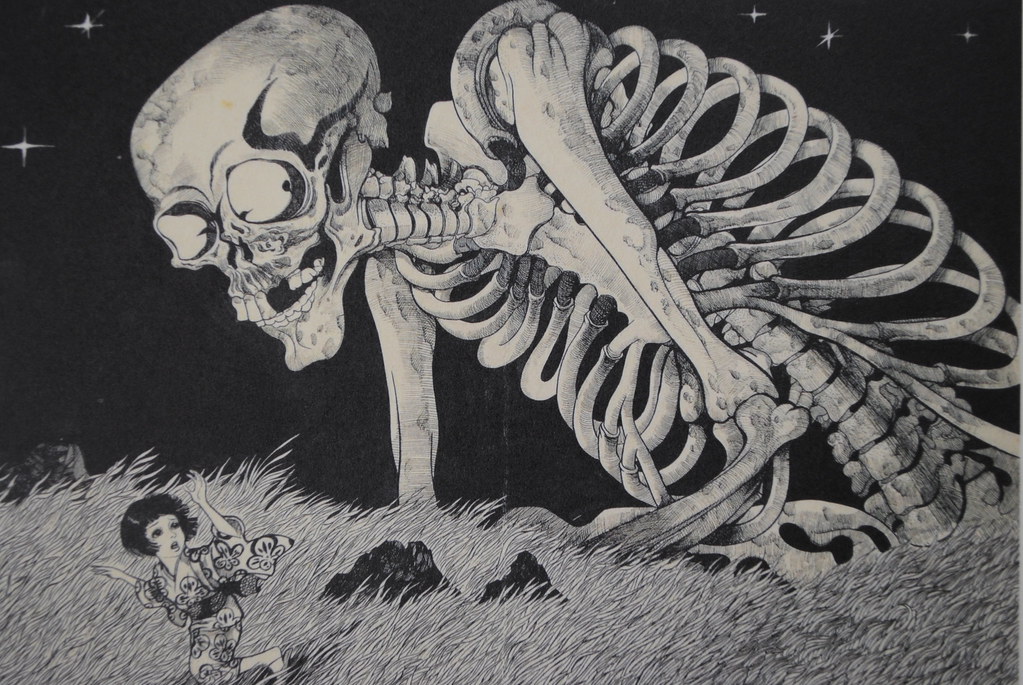

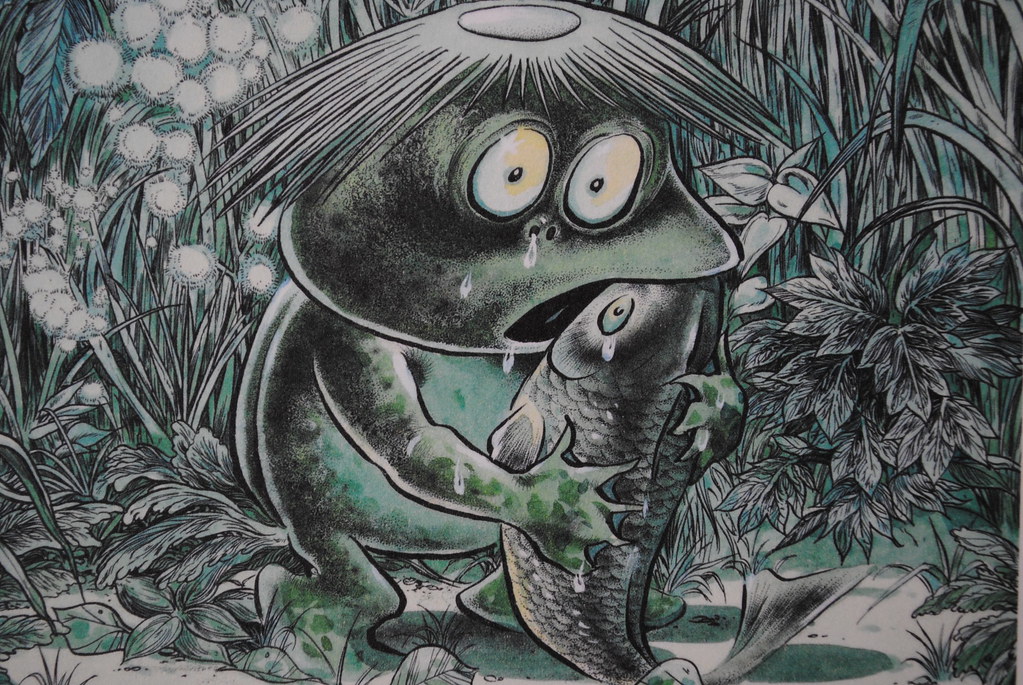
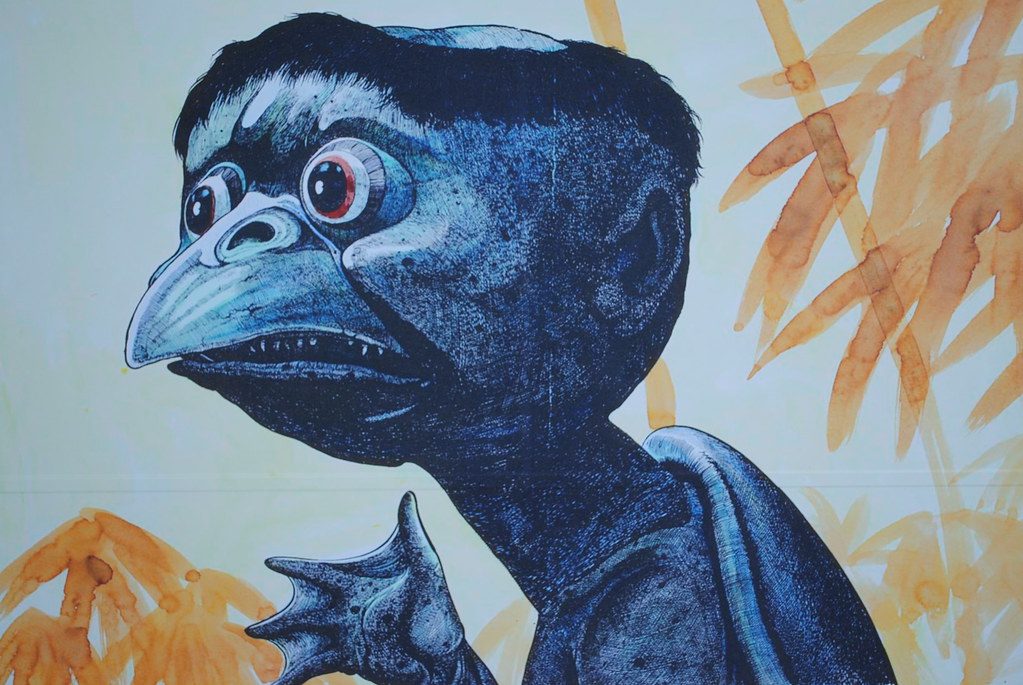
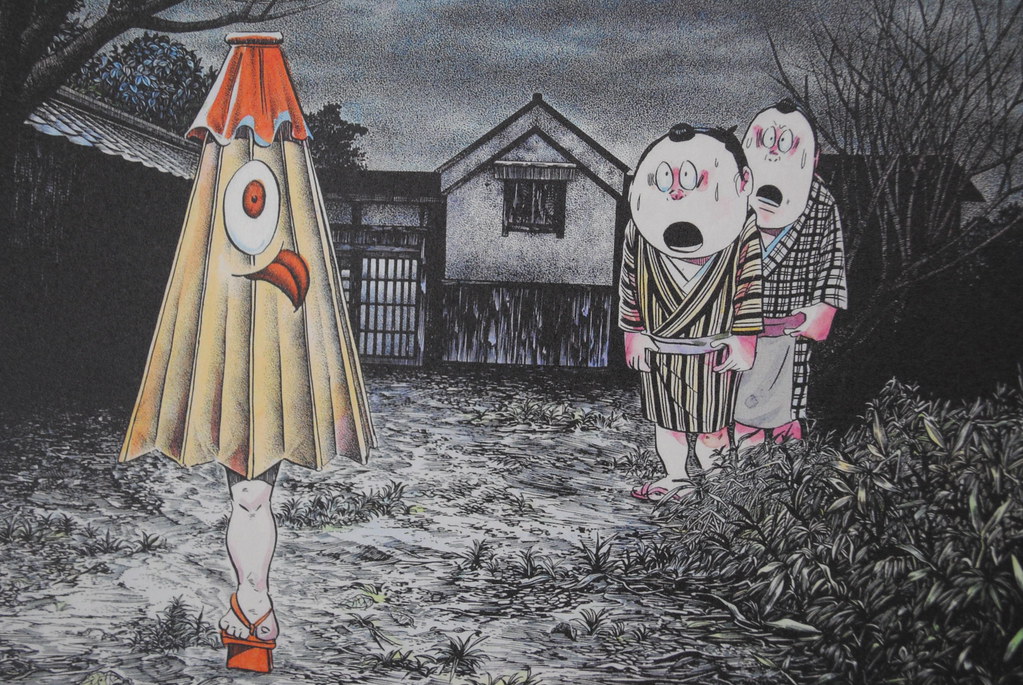
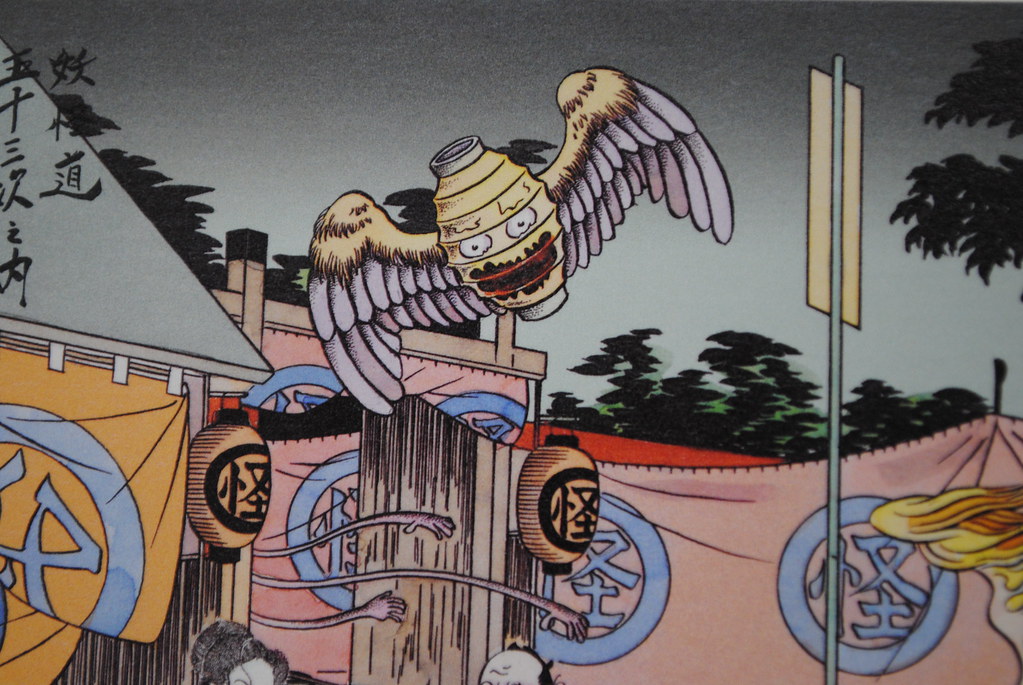
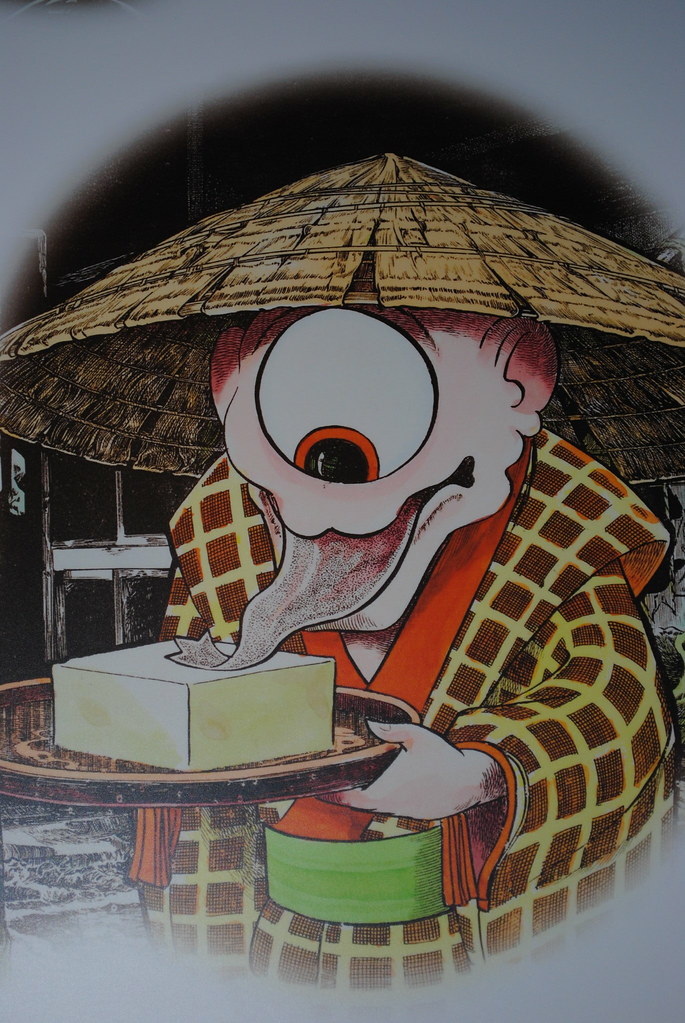
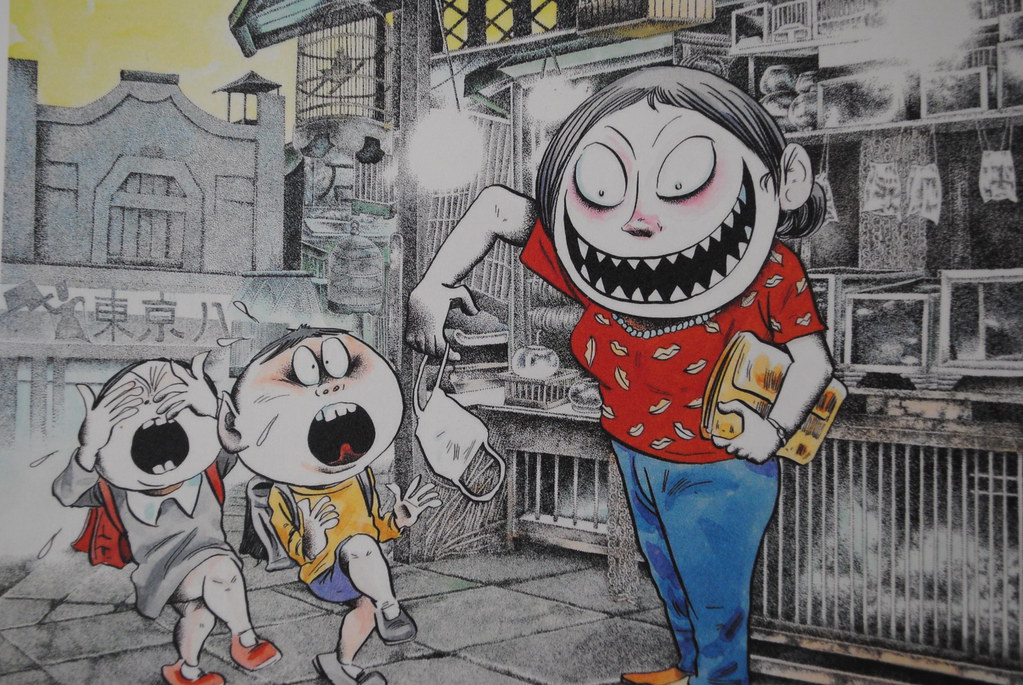
By the way, today's pictures are from a recent museum exhibition by the very talented 水木しげる (Shigeru Mizuki), a famous 漫画 author and illustrator who is renowned for his encyclopedic knowledge of お化け. His most famous work is called "Gegege no Kitarou", which has been turned into several books and アニメ series over the decades; it's an excellent choice for people who want to learn more about 妖怪 in particular.
ReplyDelete"Yokai Attack" is another good book for people who are interested - it's very light, funny, well illustrated and easy to read. It doesn't go into a huge amount of detail but it's a good introduction to 妖怪.
ReplyDeleteIt can be found in some bookshops and at:
http://www.amazon.com/Yokai-Attack-Japanese-Monster-Survival/dp/4770030703